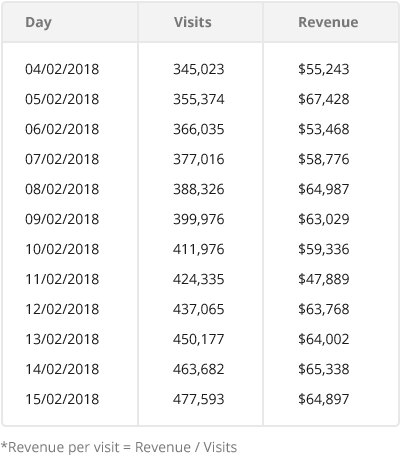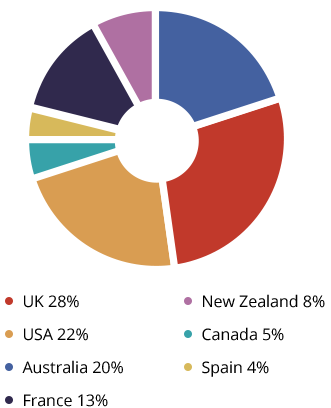Numerical reasoning tests are a type of cognitive psychometric test. While there are different types of numerical reasoning tests, for recruitment purposes there is one that is most commonly used. These standard numerical reasoning tests include a series of datasets, which normally appear as a chart, graph or table. You’ll then be presented with questions about those datasets. It’s a multiple-choice test with either 4 or 5 answer options. You normally have to interpret the data correctly and perform some basic calculations, such as percentage changes, arithmetic and ratios.
There are other types of numerical reasoning tests, but they are very rarely used in practice, and it is not worth your time to practice them. They would include mental arithmetic tests, more advanced maths and stats.
Are numerical reasoning tests called something else?
While they are normally simply called numerical reasoning tests, you might also see them referred to as data interpretation tests or numeracy tests.
What is an example of a typical numerical reasoning test?
Suppose you are faced with the two charts below. We’ll ignore the answer options (there are normally 4) – let’s just work through to find the solution ourselves.
The first question you receive is this:
“At what rate per day are Visits growing on average?” For this question, you need to find the change in the Visit metric for all the days and then take an average of those changes. As it so happens, the daily growth rate is constant at 3%.
The second question is:
“Which day had the second highest Revenue per Visit?”. Although it might be clear that Revenue per Visit means Revenue divided by Visits, this is specified explicitly in the footnote of the first table. It’s important to keep an eye for these footnotes as they often have crucial pieces of information. Anyway, you need to divide the Revenue by the Visits, rank them and choose the second highest value. It turns out that the 8th of August has the second highest.
The third question is:
“If the revenue on the 14th February 2018 is spread over the Client Countries in the same proportion as the revenue on the 7th February 2018, how much revenue would Australia have and which country’s (or countries’) revenue combined would equal $22 868.30.” This question is a little more complicated than the first two. The first step is to use the pie chart to establish the proportion of Revenue that Australia earned (20%), and multiply it by the total revenue for the 14th February. This gives you $13 067.60. That’ll give you the first part of the answer and help you eliminate a few answer options. The second part is a little trickier, but with some guesswork, the answer should be pretty clear. You should be able to see that $22 868.30 is roughly 1/3 of the Revenue for the 14th. This should help you eliminate any one country as delivering all that Revenue, because from the second chart you should see just from inspection that none contribute that much. The highest Revenue for that day is $16 457.28 for UK, and this is clearly not 1/3 of the total provided in the first table. The correct answer must therefore include two countries and you can therefore eliminate another answer option. It turns out, USA (22% * $65 338 = $14 374.36) and France (13% * $65 338 = $8 493.94) have a combined revenue of $22 868.30.
Do I need to have knowledge about the datasets?
No absolutely not. Sometimes the datasets will be about real topics, companies and events, and then sometimes they will be entirely made up. In any case, you do not need to have any knowledge about them. Your answers must be based exclusively on the data provided in the charts and questions provided.
Where can I find practice numerical reasoning tests?
You’ve come to right place. First, you can take a free numerical reasoning test right now here. Practice makes perfect as they say, and you can get great practice with a GradTests subscription. We have 6 full length numerical reasoning tests with 150 questions. All the questions come with fully worked solutions explaining the answer. You can upgrade here right now.
What are the best tricks and tips for numerical reasoning tests?
You can download a free pdf which takes you through all our top numerical reasoning tips and tricks. You can also find some great tips here too.
What’s the single best tip you have for numerical reasoning test success?
One good tip is to know when to be pragmatic and move on from a question. Numerical reasoning tests will often contain some questions in them that require an inordinate amount of calculations to obtain the correct answer. Given each question in these tests is worth the same marks as the next, there is no point labouring over one question, particularly when you can come back to it later if you still have time. These questions are deliberately inserted to slow you down and test your decision-making ability. It’s a multiple-choice quiz, and so at worst you have a 1/4 or 1/5 chance of getting it right even with a pure guess. Normally, you should be able to discount at least one option through estimation or common sense. Removing even on option dramatically improves your odds, so still do this if you can quickly.
How are numerical reasoning tests scored?
Numerical reasoning tests generally are in the form of a multiple-choice test with 4 or 5 answer options. Only one answer is the ‘most correct’ and you receive one mark for guessing this correctly. By ‘most correct’, this means the other options may also include information that is right/factually true, but there may be another answer option with more complete information.
Generally you are not penalised for incorrect answers, or in other words, there is no ‘negative marking’. Your test strategy should therefore always include guessing where you don’t know the answer.
Normally, your test answers are only submitted once you finish the test. This means that you can return to prior questions and change your answer before you finally complete the test. When you skip on from a question, you should still select an answer, even if it’s only a guess. This is because you might not have time to come back to it later. Once you have submitted your test, normally you will not be shown your results. Only the company that asked you to sit the test will receive access to your answers and score.
What do numerical reasoning tests measure?
Numerical reasoning tests measure your ability to interpret information and data in various forms, your attention to detail, your ability to work under time pressure and finally your ability to perform basic calculations such as ratios, percentages and arithmetic. Because of the data interpretation element, it’s for this reason that numerical reasoning tests are sometimes referred to as data interpretation tests.
How can GradTests help me prepare for numerical reasoning tests?
At GradTests we have a bank of 150 questions spread over 6 full length numerical reasoning tests. With our simulated test environment, you will be exposed to the time pressure that you will face on test day. Getting used to working under the clock is incredibly important to train your brain to work efficiently. Time management, and knowing when to move on from a question you’re struggling on, is critical for success.
All our numerical reasoning questions come with fully worked solutions and explanations to those solutions. This is essential for your learning – if you get an answer wrong, it’s important to understand why exactly, so that you can learn and improve your score. You can take the tests as many times as you like and access them 24/7. Our product is very affordable and represents a small investment for you in securing the job of your dreams.
With our analytics, you’ll be able to benchmark yourself against the 100 000s of other scores of our users to have taken the same test. This will help you identify where exactly your weaknesses are and help you to understand how much preparation you should be doing. You can also track your own performance over time to measure your progress.
Does practicing numerical reasoning tests improve your score?
Yes it absolutely does! Once you start practicing the tests you will come to understand the structure of the tests, you’ll get accustomed to working under time pressure and you’ll figure out all the most common tricks and traps that the providers lay for you. You’ll also feel a lot more relaxed and confident because you know what you expect when sitting the test – there is no more fear of the unknown.








